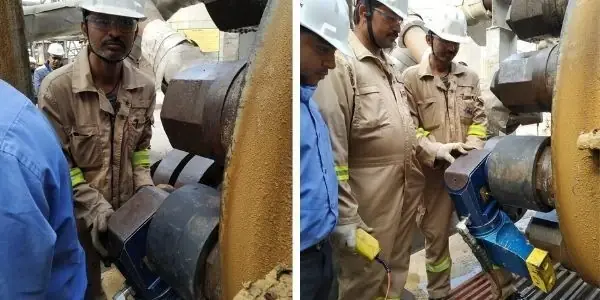Experienced in the industry for almost two decades, we offer onsite machining and bolting services with the help of our skilled and experienced manpower of over 150 technicians.Combining our skilled manpower and tools, we offer onsite industrial services on torqueing, tensioning, cold pipe cutting, pipe beveling, flange facing and serration, nut splitting and many more. As an industry leader, we specialize in completing complex jobs efficiently for major industries like Power, Oil and Gas, Petrochemicals, Heavy Engineering, Mining, and Shipping.
In this article, we would like to present a case study which will not only highlight the importance of bolting, but also justify our commitment towards completing complex jobs efficiently. Recently, our bolting experts were working on a complex maintenance job for a chemical manufacturing major.
Based on a leaking flange, our client was looking for flange-facing services. Our team of technicians visited the site, to conduct an inspection and provide a Root Cause Analysis (RCA) report to find the right solution. Post inspection, our engineer identified that the flange had a special type 2 degree gasket and that the groove of the flange was damaged which was causing the leakage. On further inspection, our engineer figured out that the flange was inaccurately bolted.
Unaware of the importance of controlled bolting and bolt tightening sequencing, the customers’ technicians were using conventional methods like hammer and cranes to tighten the bolts. To ensure precision bolting, multiple factors like torque calculation, gap measure, stress distribution, and compressive force calculation for bolt tightening process are taken into consideration. However, none of these were taken in to consideration while manually bolting.
On calculating all the mentioned factors, we identified the torque output required for accurate tightening was 62,500 Nm. Since the torque requirement was high, we recommended our reliable hydraylic torque wrench which could deliver torque up to 71,169 Nm.
Upon our customer’s approval to conduct the job, we were able to fix the leakage with controlled bolting methods within 3.5 hours with 3 crew members and a supervisor. The client was astonished, as earlier it took him 7 days and more than 28 employees to tighten the same. Also, while comparing a hydraulic torque wrench with the conventional method, it is safer to operate. It not only eliminates the risk of injuries of hammer slippage but also the chances of the bolt/ flange breaking due to over or under torqueing. The joint was pressure test at 350 bar without any leakages.
This means that not only did controlled bolting help achieve accurate torque output but also enhanced the safety, productivity and efficiency of the plant. Addressing that, we would like to conclude by highlighting the importance of conducting an RCA before resolving the issue. As a customer-centric brand, we believe and have always recommend a consultative-sales approach through our end to end bolting services. Visit us next time for more cases highlighting the importance of controlled bolting and machining solutions.


